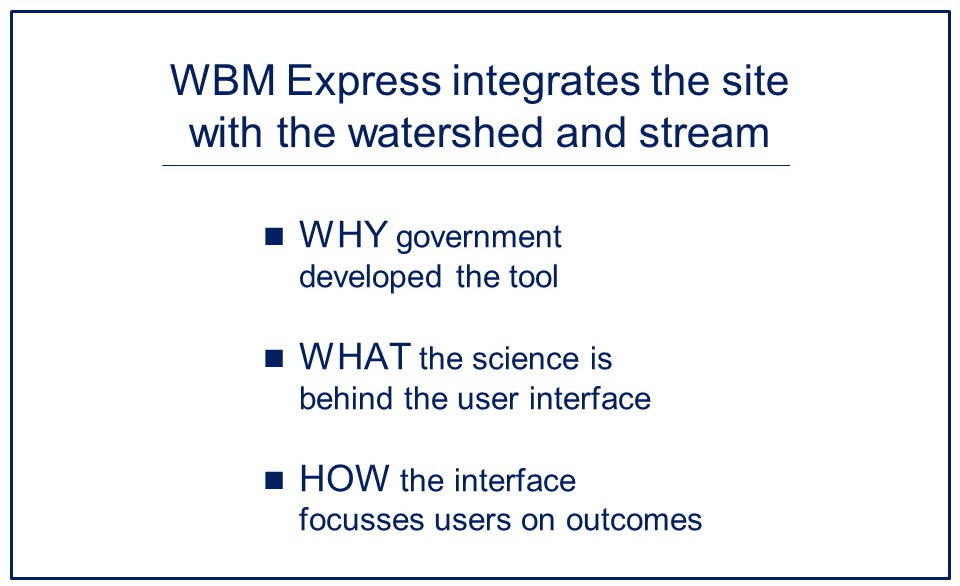WBM Express introduced to Comox Valley Regional District in July 2013
Watershed-Based Approach to Rainwater Management
“Recognizing the importance of the issue, the Regional Board identified a rainwater strategy as a NOW priority in its September 2012 Strategic Plan. An action item was a  legal and technical review of current practices and future options. This work has been completed, recommendations were approved by the Board in March 2013, and implementation of first steps is proceeding,” stated Kevin Lorette in an April 2013 announcement. At the time, he was General Manager of the Property Services Branch for the Comox Valley Regional District (CVRD) on the east coast of Vancouver Island.
legal and technical review of current practices and future options. This work has been completed, recommendations were approved by the Board in March 2013, and implementation of first steps is proceeding,” stated Kevin Lorette in an April 2013 announcement. At the time, he was General Manager of the Property Services Branch for the Comox Valley Regional District (CVRD) on the east coast of Vancouver Island.
“Rainwater management policy statements and development permit area guidelines will be developed; will include objectives to address climate change impacts, adaptive management and performance standards; and will be implemented as part of the current Official Community Plan review. A report on the resource requirements and next steps for implementing a rainwater management strategy for the Comox Valley Regional District Electoral Areas will be prepared as the next step in this process,” he added.
In July 2013, the CVRD held a sharing and learning session which was built around a discussion of legal and policy options, and a presentation on the Water Balance Model Express for Landowners.
Connect Dots to Official Community Plan
“The idea was to demonstrate not only the tool but also the thinking and performance standards behind it, which we will (ideally) be incorporating into the new Official Community Plan and bylaws,” stated Tanis Gower, the project lead.
 “With my current understanding, I see the WBM Express as a tool that would not necessarily be referenced in the OCP and other bylaws, but that the performance standard built into it would be. Staff would direct individual landowners wanting to do small developments towards the WBM Express. Developers of large subdivisions would still need to hire an engineer but could check the results against the WBM if they wished.”
“With my current understanding, I see the WBM Express as a tool that would not necessarily be referenced in the OCP and other bylaws, but that the performance standard built into it would be. Staff would direct individual landowners wanting to do small developments towards the WBM Express. Developers of large subdivisions would still need to hire an engineer but could check the results against the WBM if they wished.”
Understand the Natural Water Balance
The discussion about the web-based WBM Express was a collaborative effort by Kim Stephens, Executive Director of the Partnership for Water Sustainability in BC, and Jim Dumont, the Partnership’s Engineering Applications Authority.
 “We structured the information sharing in three parts,” states Kim Stephens. “First, we elaborated on WHY government almost $3 million in Water Balance tool development and outreach. Then we provided an overview of the science and explained the significance of each of the three performance targets that are integrated and balanced within the WBM Express. Finally, we highlighted how the interactive interface helps tool users to focus on solutions and outcomes.”
“We structured the information sharing in three parts,” states Kim Stephens. “First, we elaborated on WHY government almost $3 million in Water Balance tool development and outreach. Then we provided an overview of the science and explained the significance of each of the three performance targets that are integrated and balanced within the WBM Express. Finally, we highlighted how the interactive interface helps tool users to focus on solutions and outcomes.”
 “We find it is important to ensure that our audiences understand the distinction between the Water Balance Methodology and the Water Balance Model,” continues Jim Dumont. “At the heart of the Water Balance Methodology is recognition of the integrated significance of the three flow paths (surface runoff, interflow and deep groundwater), the period of time required for rainwater to reach the stream via each flow path, and the need to protect and maintain the natural distribution of rainwater via each flow path.”
“We find it is important to ensure that our audiences understand the distinction between the Water Balance Methodology and the Water Balance Model,” continues Jim Dumont. “At the heart of the Water Balance Methodology is recognition of the integrated significance of the three flow paths (surface runoff, interflow and deep groundwater), the period of time required for rainwater to reach the stream via each flow path, and the need to protect and maintain the natural distribution of rainwater via each flow path.”
To Learn More:
To download a copy of the report on the legal and technical review, click on Rainwater Management in the Comox Valley Regional District Electoral Areas: Current Practice and Future Options.
To download a PDF copy of the PowerPoint presentation by Kim Stephens and Jim Dumont, click on An Introduction to the WBM Express for Landowners.



